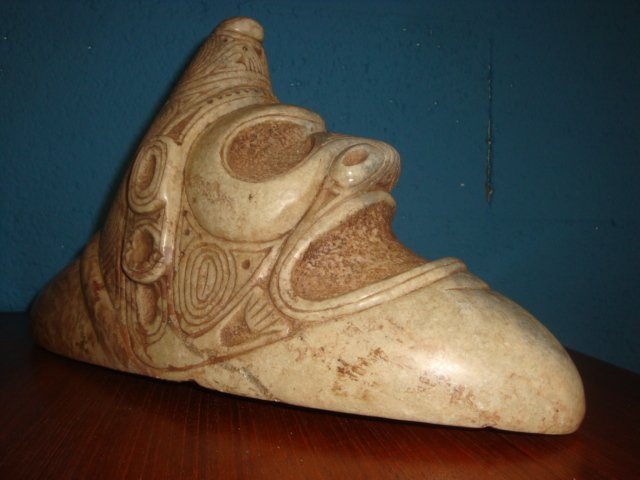
Titanium bergkristal aura (Vlamaura) geode - Hoogte: 3 cm - Breedte: 8.5 cm- 260 g
Nr. 21415751

Nr. 21415751

TRIGONOLITHE representing a YUKAHU Zemi
This triangular object, called "trigonolithe" by archaeologists, consists of three points, the front and rear form the head of the divinity Zemi and its folded legs, while the central part with bulge evokes a woman's breast. Christophe Colomb gave us the following meaning for it: a tip would refer to the tubers such as cassava, the second would facilitate women in giving birth, and the last would be conducive to water and sun, essential elements for a good harvest.
Object of devotion by excellence, the trigonolithe accompanied the behiques in their ceremonies, notably during the Cohoba ritual and was buried afterwards as an offering to promote fertility of the Earth as well as human beings.
The piece shown here, is highly decorated traditional glyphs
Greenish/greyish stone
Taino Culture, Dominican Republic, 1600-1800 AD
Dominican Republic
PROVENANCE: PRIVATE COLLECTION ACQUIRED BY MESELF AROUND 1998/2000
REFERENCES
- Taino "peuple d'amour" (Thierry Cruckert Bernard Michaut France)
- Taino "art of the gods" (Larry Roberts USA)
- Art Taino (Jacques Kerchache France)
- Joyaux de l'Art Taino (République Dominicaine)
- The Tainos Rise and Decline of the people who greeted Colombus (Irving Rouse)
- Arts and Archeology of Precolumbian Cuba (Ramon D Moure and Manuel Rivero de la Calle)
- The Barakat Collection
A Zemi is the physical manifestation of a god, spirit or ancestor. The Zemi has round eye sockets and an oval-shaped mouth. This is made possible by inducing a hallucinogenic state by inhaling Cohoba. This was definitely an object of considerable spiritual and social significance for its original owners and continues to amaze us today.
Taino Culture, Dominican Republic, 1200-1500 AD
The Taino were an ethnic group of the Arawak peoples, who were the indigenous people of the Caribbean and Florida. At the time of contact with Europeans in the late 15th century, the Taino were the main inhabitants of Cuba, Jamaica, Hispaniola (Dominican Republic and Haiti) and Puerto Rico. They spoke a distinct language, the Taino language. According to the Taino of the Caribbean, a zemi was a deity or an ancestral spirit; Furthermore, the term also includes the sculpture which houses the spirit. The Taino religion, as it was recorded by the Spaniards in the late 15th and 16th centuries, was focused on a supreme creator god and a fertility goddess. The creator god was known by the name of Yúcahu Maórocoti, responsible for the growth of the base food, manioc. The goddess was Attabeira, who regulated and dominated water, rivers and seas. The inferior gods who ruled over the other forces of nature were also zemis. The spirits of the ancestors were also considered zemis and were honoured, particularly those of the chiefs or caciques. Bones or skulls were often incorporated into sculptures of zemis. Zemis would also be consulted for guidance and healing. At these consultation ceremonies, zemi images could be painted or tattooed on the bodies of the priests. Zemis were usually carved from a wide variety of materials, including bones, clay, wood, shell, sandstone and other types of stone. They have been found in Cuba, Dominican Republic, Haiti, Jamaica, Puerto Rico and other Caribbean islands. Some are quite large, up to 1m in height. Some could be effigies of birds, snakes, alligators and other animals, but mostly human effigies. It is believed that the Taino people hid their ceremonial objects in caves, away from the Spaniards, or destroyed them to prevent them from falling into their hands.
The Taino communities were the first that Columbus met during his exploration of Hispaniola in 1492. Traditional pre-Columbian research concentrated on the continental societies of the Incas, the Aztecs and the Mayans, but since the 1950s, the Taino culture has become more and more sophisticated, deserving more detailed studies. Politically, the Taino were divided into distinct communities led by chiefs (caciques) whose power had increased significantly at the time of the arrival of the Spaniards. Religiously, the Taino were polytheists and worshipped a pantheon of gods that they believed controlled the natural elements. The worship of ancestors was also important and the deification of deceased leaders reinforced the political authority of their successors. An elaborate ritual system was developed to honour and appease the deities (zemis) and this probably provided the context for this object.
Zo koop je op Catawiki
1. Ontdek iets bijzonders
2. Plaats het hoogste bod
3. Veilig betalen